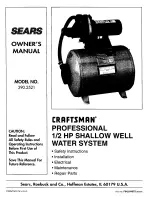
i
INTRODUCTION – DESCRIPTIONS AND DEFINITIONS
You have purchased one of the most technologically advanced Ultraviolet Water Treatment System available anywhere in the world. It has
been designed with you, the consumer, in mind. UV products are lightweight, easy to use, and simple to maintain. UV products will provide
you with healthy, clean drinking water for years to come.
WHAT IS ULTRAVIOLET?
Ultraviolet (UV) light from the sun has long been known for its ability
to destroy microorganisms. However, it has only been in recent
years that equipment producing UV light has been manufactured for
residential use.
WARNING:
NEVER LOOK DIRECTLY AT A LIGHTED UV LAMP.
ULTRAVIOLET RAYS CAN BE HARMFUL TO EYES.
UV energy is produced by low-pressure mercury vapor enclosed in
a tubular lamp. While a UV lamp resembles a standard fluorescent
lamp, it is similar in appearance only.
Energy produced by the UV lamp has the ability to destroy
microorganisms that can live in water. There are five major groups of
microorganisms that are altered by a specific spectrum of ultraviolet
light: viruses, bacteria, fungi, algae, and protozoa.
When these microbes are exposed to the proper amount of UV
energy, their DNA structure is scrambled, and they are unable to
reproduce. Since the cell is now sterile or dead, it is no longer a
threat.
WHAT IS ACTIVATED CARBON?
Activated carbon has been used for hundreds of years to treat
taste, odor, and color problems in water. Activated carbon has been
proven to be an excellent media to produce better tasting water and
to remove harmful water contaminants at a reasonable cost.
Carbon used for filters may be manufactured from wood, coal, or
coconut shells. The raw carbon is ground up and “activated” by
heating the granules at a controlled temperature and pressure.
This process causes the carbon granules to expand and create
active sites where pollutants can be collected by adsorption. These
new sites dramatically increase the total surface area and capacity
of each granule.
WHAT IS ADSORPTION?
Adsorption is the physical process where certain water pollutants
are attached to the surface of carbon particles as the water flows
through the filter. The pollutants are removed from the water and
locked into the carbon granule.
Activated carbon is also able to filter out sediment through a process
of mechanical filtration. The particles are captured in the spaces
between carbon granules.
UV SYSTEMS
It is recommended that all UV systems include pre-filters to process
the water before it reaches the UV lamp. This will ensure that
maximum UV exposure is achieved.
UV UVB, UV20 and UVBB series offers integrated filters in a single
system. These integrated systems use a two-stage filtration process:
First, a string-wound filter removes the suspended solids that may
shield the microbes and make it difficult to obtain sufficient UV
exposure. Second, an activated carbon filter removes unpleasant
tastes and odors.
UV Ultraviolet Water Treatment Systems are designed for indoor
use only.
UV Systems are designed to provide complete water treatment in
a compact, easy-to-use package. Please follow the directions in
this Guide exactly when installing your UV System to ensure that it
operates correctly.
The UV lamp requires a start-up period of one to two minutes in
order to achieve full intensity. Repeated starting of the UV lamp
will shorten its life. Therefore, it is recommended that the UV lamp
remain on at all times during use.
CONDITIONS FOR USE
Source Water Supply Profile
Chemical Parameters
Max mg/L
Feed Water Pressure†
20 – 75 psig (138 – 517 kPa)
Hardness (CaCO
3
)
< 120 (7 gpg)
Feed Water Temperature
38° – 105°F (3.3°– 40.5°C)
Iron (Fe)
< 0.3
pH Range
6.5 – 9.5
Manganese (Mn)
< 0.05
Total Dissolved Solids
<1500 mg/L
† Water Pressure must not exceed 75 psig (517 kPa) or a pressure
regulator must be installed.
Total Suspended Solids
< 10 mg/L
Turbidity
< 5 NTU
Summary of Contents for Aqua Flo ADDON Series
Page 2: ......





































